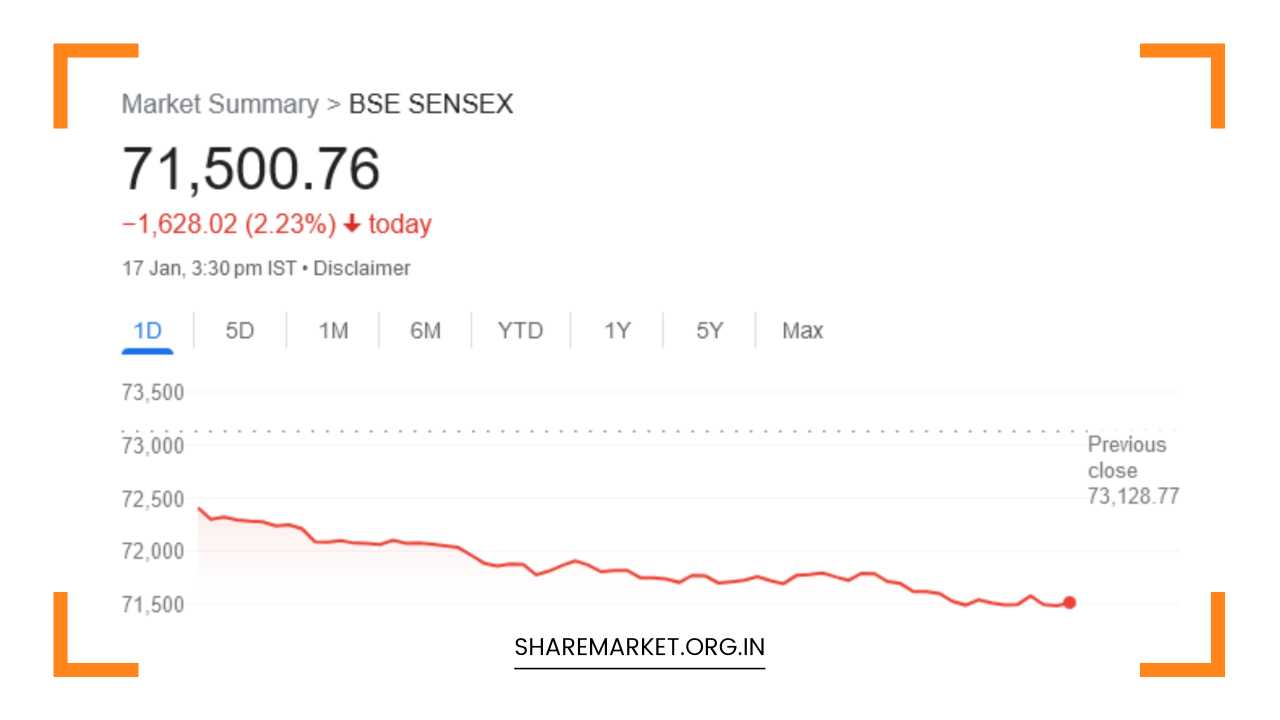Stock Market Crash: How Much More the Sensex will Fall?

Stock Market Crash
Market Turmoil: Unraveling the Causes, Implications, and Investment Strategies
The financial markets experienced a tumultuous day, witnessing the most significant fall in the last 18 months. Investors grappled with a staggering loss of around Rs 4.4 lakh crore in a single day, sending shockwaves across Dalal Street.
The Sensex tumbled by 1628 points, and Nifty took a hit with a 2 percent decline, creating an atmosphere of panic and uncertainty.
The epicenter of this market upheaval was undoubtedly the banking sector, with HDFC Bank, the largest private bank in the country, leading the downturn.
This drastic turn of events was fueled by the disappointing December quarter results of HDFC Bank, which, in turn, dampened the performance of IT stocks.
Amidst this chaos, investors are left pondering the duration of this market decline and whether it presents an opportunity for strategic investment.
Market Analysis:
The biggest casualty of today’s market decline was witnessed in banking shares, particularly with HDFC Bank at the forefront.
The bank’s disappointing December quarter results triggered a chain reaction, causing a subdued rise in IT stocks as well.
The overall market sentiment was characterized by panic and apprehension, especially on Dalal Street, where the palpable fear of sustained losses permeated the trading floor.
The Sensex’s precipitous fall of 1628 points is a cause for concern, reflecting a broad-based decline across sectors. Nifty, experiencing a 2 percent drop, further compounded the market’s distress.
The banking sector, in particular, bore the brunt, with Bank Nifty recording a significant 4.2 percent decline throughout the day.
Private sector banking giants, including HDFC Bank, Kotak Mahindra Bank, Axis Bank, and ICICI Bank, emerged as the top losers among Sensex stocks.
HDFC Bank’s market capitalization alone witnessed a staggering reduction of Rs 1.1 lakh crore, amplifying the severity of the market downturn.
HDFC Bank’s Role in the Decline:
The spotlight remains firmly on HDFC Bank as the primary catalyst for the market decline. The bank had released its December quarter results a day earlier, and the outcomes failed to meet investors’ expectations.
A key factor contributing to the lackluster performance was the flat margins on a quarterly basis, attributed to the high cost of funds. Analysts hold mixed views on HDFC Bank’s margins, with BNP Paribas expressing skepticism about reaching 4.3 percent anytime soon.
The reduction in the target price of HDFC Bank by HSBC analysts from Rs 2,000 to Rs 1,950 further underscored the prevailing concerns.
Despite these challenges, Gaurang Shah of Geojit Financial maintains a bullish outlook on the stock, emphasizing the bank’s robust 16-17 year history. Shah contends that it is premature to judge the bank based on the results of a single quarter.
Market Expert Perspectives:
Market experts have weighed in on the current scenario, providing insights and guidance for investors navigating through this turbulent period.
According to Ajit Mishra, Senior Vice-President Technical Research at Religare Broking, Nifty has entered a critical support zone of 21,700 to 21,800, with signs of weakening bullish control.
Mishra attributes the market’s decline on January 17 to major banking stocks, predicting sustained pressure in the future. He cautions that Nifty might break down to the level of 21,400 to 21,200 if the current trend persists.
The cautionary stance is echoed by other market analysts who predict a potential intensification of the market decline in the coming days.
The ongoing quarterly results season has been identified as a crucial factor influencing market dynamics. Investors are advised to exercise prudence and wait for the outcome of these results before committing new capital to the market.
Bank Nifty, having experienced a significant 4.2 percent decline, is under scrutiny, with Ajit Mishra warning that a breach of the 45,700 level could lead to a further 1,000-point fall.
Among Sensex stocks, private sector banks, including HDFC Bank, Kotak Mahindra Bank, Axis Bank, and ICICI Bank, emerged as the top losers, underscoring the vulnerability of the banking sector to the prevailing market conditions.
IT Stocks Resilience:
Amidst the market turmoil, a notable exception to the general decline was observed in IT stocks. Analysts attribute this resilience to the better-than-expected December quarter results of IT companies.
However, they caution investors to wait for fundamental triggers before diving into IT stocks. AK Prabhakar, Research Head at IDBI Capital, highlights that despite surpassing market expectations, most IT companies still exhibit flat growth.
The bullishness in the IT sector, driven by encouraging results, is viewed with a degree of skepticism, considering the overall tepid growth.
Investment Strategies:
As the market grapples with uncertainty, investors find themselves at a crossroads, contemplating whether the current decline presents an opportunity or warrants caution.
Ajit Mishra suggests that the current market scenario demands patience, especially with the ongoing quarterly results season. Investors are advised to wait for these fundamental triggers before making new investment decisions.
Gaurang Shah’s optimistic outlook on HDFC Bank, despite the recent downturn, underscores the importance of considering a company’s long-term track record. Shah believes that judging a bank solely based on the results of one quarter may be premature, especially when evaluating a financial institution with a solid history spanning nearly two decades.
On the other hand, cautionary signals from analysts such as BNP Paribas and HSBC highlight the need for a thorough assessment of risks and a nuanced understanding of market dynamics.
While uncertainties loom, analysts like AK Prabhakar stress the importance of patience, particularly for those eyeing long-term investment opportunities.
Final Remarks:
The current market turmoil, driven by the significant fall in banking shares and exacerbated by HDFC Bank’s disappointing results, has sent shockwaves through Dalal Street. As investors grapple with losses and uncertainties, market experts offer cautionary advice, emphasizing the need for patience and a comprehensive understanding of the evolving market dynamics.
The ongoing quarterly results season is expected to be a pivotal factor shaping the market landscape in the coming days.
Whether this decline is a temporary setback or a harbinger of a prolonged bearish phase remains uncertain. In navigating these turbulent waters, investors must exercise prudence, wait for fundamental triggers, and carefully evaluate the long-term prospects of the companies in which they plan to invest.

















